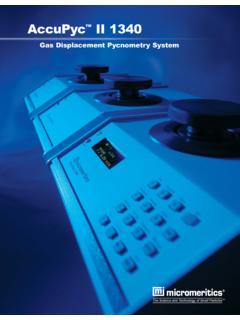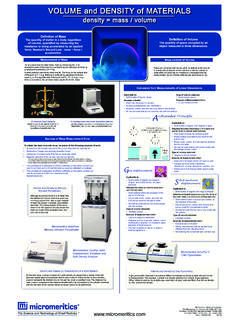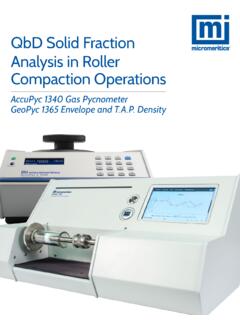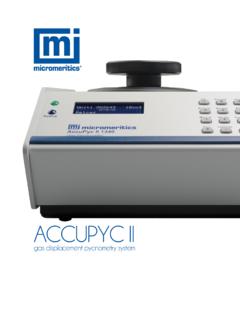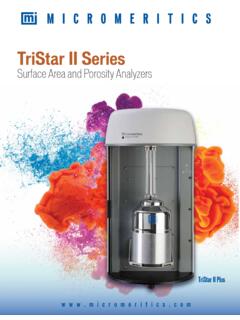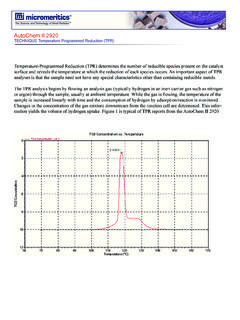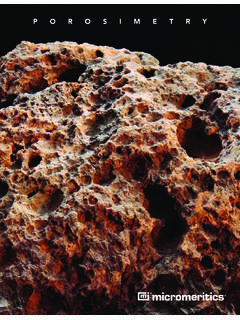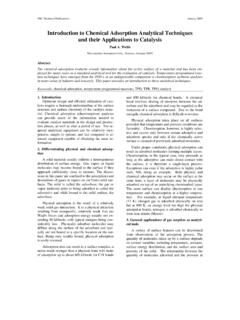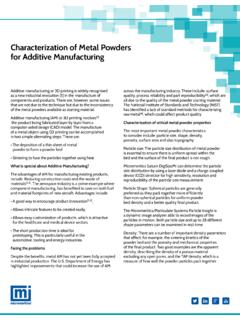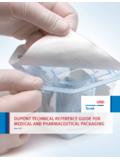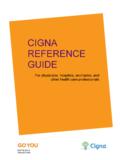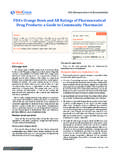Transcription of The Characterisation of Pharmaceutical Materials by ...
1 Dynamic Vapour Sorption Application Note 10101 Last Updated 24/11/06 1 Surface Measurement Systems Ltd Introduction The water vapour or moisture sorption properties of Pharmaceutical Materials such as excipients, drug formulations and packaging films are recognised as critical factors in determining their storage, stability, processing and application performance [1,2]. Moisture sorption properties are routinely determined for many Pharmaceutical Materials and have traditionally been evaluated by storing samples over saturated salt solutions of established relative humidities and then regularly weighing until equilibrium is reached [3-5].
2 However, there are a number of disadvantages with these methods, including: (i) the prolonged period of time taken for the samples to reach equilibrium using a static method, often many days commonly many weeks. (ii) inherent inaccuracies as the samples have to be removed from the storage container to be weighed which can cause weight loss or gain. (iii) static methods necessitate the use of large samples sizes (typically >1gm). (iv) the highly labour intensive nature of static methods. A new, highly sensitive, accurate and rapid means for determining the moisture sorption properties of solid Pharmaceutical Materials is described below. Experimental The data described below were obtained using the Dynamic Vapour Sorption (DVS) methodology developed by Surface Measurement Systems (SMS) Ltd.
3 For the rapid quantitative analysis of the water sorption properties of solids including Pharmaceutical Materials . A schematic of a DVS automated gravimetric sorption system is shown in Figure 1. The Surface Measurement Systems DVS instrument, now in use by many Pharmaceutical companies world-wide, rapidly measures uptake and loss of moisture by flowing a carrier gas at a specified relative humidity (RH) over a sample (1mg - ) suspended from the weighing mechanism of a Cahn D-200 ultra-sensitive recording microbalance. This particular microbalance is used as it is capable of measuring changes in sample mass lower than 1 part in 10 million and provides the unrivalled long-term stability required for the accurate measurement of vapour sorption phenomena, which may take from minutes to days to complete depending upon the sample size and material.
4 Indeed, a major factor in determining the water sorption behaviour of Materials is the need to establish rapid water sorption equilibrium, therefore the DVS instrument allows sorption behaviour to be accurately determined on very small sample sizes (typically 10 mg), thus minimising the equilibration time required. One of the most critical factors for any instrumentation used The Characterisation of Pharmaceutical Materials by Dynamic Vapour Sorption Carl L. Levoguer and Daryl R. Williams Figure 1. Schematic of a DVS-1 instrument. Regulated Dry Gas FlowMicrobalanceMass Flow Controller 1 Mass Flow Controller 2 Temperature Controlled IncubatorVapourHumidifierSample HolderReference HolderTemp/HumidityProbesDynamic Vapour Sorption Application Note 101 Last Updated 24/11/06 2 Surface Measurement Systems Ltd for investigating moisture sorption behaviour is the temperature stability of the measurement system.
5 The main DVS instrument systems are therefore housed in a precisely controlled constant temperature incubator with a temperature stability of C. This ensures very good instrument baseline stability as well as accurate control of the relative humidity generation. The required relative humidities are generated by accurately mixing dry and saturated vapour gas flows in the correct proportions using mass flow controllers. Humidity and temperature probes are situated just below the sample and reference holders to give independent verification of system performance. The microbalance mechanism is very sensitive to sorption and desorption of moisture, therefore a constant dry gas purge to the balance head is provided to give the best performance in terms of baseline stability.
6 The purge flow is manually controlled such that in the event of a power failure, condensation of moisture in the balance head cannot occur. The DVS instrument is fully automated under control from a dedicated IBM compatible PC microcomputer. The DVSWIN software package supplied with the instrument provides a flexible and easy to use interface for setting up and running moisture sorption /desorption experiments on the DVS instrument. In addition, the DVS Data Analysis Suite, which runs from within Microsoft Excel, provides a powerful environment for rapid plotting and quantitative analysis of data. Results and Discussion The following results, obtained using a DVS-1 instrument, highlight the versatility and power of Dynamic Vapour Sorption method.
7 Moisture Sorption of Microcrystalline Cellulose RM 302 Microcrystalline cellulose (RM 302) is an EC reference material for measuring moisture sorption isotherms on Pharmaceutical and food Materials and has been the subject of an extensive EC-wide study using the COST 90 procedure [6]. Figure 2 shows the kinetic data for a water sorption isotherm measured on RM 302 at 25 C using a DVS-1 instrument. These data demonstrate the rapid establishment of equilibrium using this technique; the whole sorption isotherm was measured accurately within hours using the DVS instrument, whereas each point on a similar sorption isotherm took a minimum of 7 days to measure using the COST 90 procedure.
8 Table 1 shows the certified equilibrium moisture content for RM 302 measured by the COST 90 procedure together with the mean of 4 sets of DVS-1 data from two different laboratories. The DVS-1 data agrees well with the COST 90 data and the small standard deviation for the DVS data demonstrates the very good reproducibility of the instrument. RM-302 is increasingly being used as a standard material for validating the performance of the DVS instrument within Pharmaceutical laboratories. Polymorphism in Spray Dried Lactose The collapse of amorphous spray dried Materials above a certain critical humidity is a recognised problem within Pharmaceutical product development. Recently a DVS methodology has been used to estimate the amorphous contents of lactose powders for amorphous contents as low as (compared to 10% detection limit for X-Ray Diffraction) [7].
9 Figure 2. Kinetics of moisture sorption of RM302. 024681012140500100015002000 Time/mins0102030405060708090100 Relative Humidity (%)Dynamic Vapour Sorption Application Note 101 Last Updated 24/11/06 3 Surface Measurement Systems Ltd Automated computer control of the DVS instrument allows novel experimental approaches to be adopted for rapidly investigating such Materials . The data in Figure 3 demonstrates the physico-chemical behaviour of a highly amorphous lactose sample by using a rapid humidity ramping methodology. After an initial drying period, the sample was subjected to a linear humidity ramp of 10% RH per hour from 0 to 100% RH at 25 C. The sample was then dried and a second ramping cycle performed.
10 The first cycle data shows the rapid uptake of moisture by the amorphous powder up to a critical moisture content at around 60% RH above which rapid loss of moisture is observed. This observed loss of moisture might be attributed to recrystallisation of amorphous material caused by a moisture induced lowering of the glass transition temperature (Tg) of the amorphous regions in the sample to below 25 C. The data for the second cycle shows very little moisture uptake and is similar to that observed for crystalline -lactose monohydrate, indicating that virtually all of the amorphous content of the sample recrystallised in the first cycle. These data therefore demonstrate the power of the DVS instrument to detect polymorphism in certain Pharmaceutical Materials .
